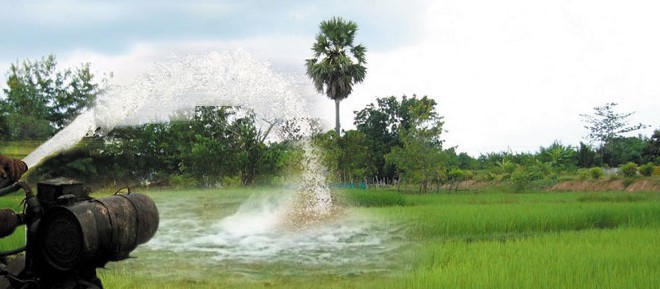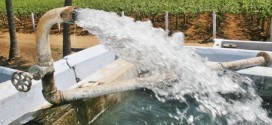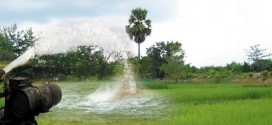CRITICAL GROWTH STAGES AND WATER REQUIREMENTS OF IMPORTANT CROPS Crop Critical growth stages Average crop duration (days) Water requirement (mm) Rice Tiller initiation, flowering and milky stage 90-130 900-2500 Crop Critical growth stages Average crop duration (days) Water requirement (mm) Wheat Crown root initiation, flowering, joining, milky and tillering 135 400-450 Crop Critical growth stages Average crop duration (days) Water requirement (mm) Pulses Flower initiation and pod filling 90-120 250-300 Crop Critical growth stages Average crop duration (days) Water requirement (mm) Groundnut Pegging and pod formation 105 600-450 Crop Critical growth stages Average crop duration (days) Water requirement (mm) Sugarcane Emergence, tiller formation and elongation 330 1400-3000 Crop Critical growth stages Average crop duration (days) Water requirement (mm) Banana Early vegetative phase, bunch initiation and flowering 300 3000 Crop Critical growth stages Average crop duration (days) Water requirement (mm) Cassava Rooting, early tuberization and tuber development 300 400-750 Crop Critical growth stages Average crop duration (days) Water requirement (mm) Maize Silking and cob development 100 400-600 Crop Critical growth stages Average crop duration (days) Water requirement (mm) Sorghum Knee-height stage, flowering and grain filling 100-120 250-300 Crop Critical growth stagesAverage crop duration (days) Water requirement (mm) Cotton Commencement of sympodial branching, flowering, boil formation and boil bursting 165 600-700
Read More »Water
Pumpset Selection
1 H.P Pumpset gives a discharge of 2200 gallons/hr. normally. Viz. 22,000 gallons in 10 hrs (1 inch of water in one acre – 1 acre inch). Discharge according to size of pumpset 1 H.P., 1″ x 1″, 1 1/2″ x 1 1/2″ pumpsets – 2,000 – 3,000 gph. 1 1/2 H.P., 1 1/2″ x 1″, 2″ x 1 1/2″ pumpsets – 3,000 – 4,000 gph. 2 H.P., 2″ x 2″, 2 1/2″ 2″, 3″ x 2 1/2″ pumpsets – 5,000 – 6,000 gph. 3 H.P., 2 1/2″ x 2″, 3″ x 2 1/2″ 2″ x 2″ pumpsets – 6,000 – 7,000 gph. 5 H.P., 4″ x 3″, 3″ x 2 1/2″, 2 1/2″ x 2″ pumpsets – 10,000 – 12,000 gph. Working out area and depth of irrigation. Example: 5 H.P. Pumpset. If this pump is worked for 10 hrs, it gives a discharge of 1,10,000 gallons of water approximately. If the area of the farm is five acres, the depth of water will be 1,10,000/22,000 which is five inches (22,000 gallon = 1 inch in one Acre). Precautions to be taken while errecting a pump Maximum suction head shall not exceed 7 mts. (20 ft). Suction head is measured from water surface of source to pump level vertically. Suction pipe shall be erected vertically. It shall never be allowed in a slanting position. There shall not be any leak on the suction side. Foot valve must rest at least 1 mt. above the water bed. If foot valve touches ground, it will such dirt and sand, and pumping system will fail. Polythene pipes are preferable to avoid frictional loss. Usually centrifugal pumps are used where suction is less than 7 mts. A single stage pump is used where total head (suction head + delivery head) isj not more …
Read More »Consumptive use and water efficiency
Only a small fraction (0.1% to 1%) of the water used by a plant is held within the plant. The majority is ultimately lost via transpiration, while evaporation from the soil surface is also substantial. Transpiration plus evaporative soil moisture loss is called evapotranspiration. Evapotranspiration plus water held in the plant totals consumptive use, which is nearly identical to evapotranspiration. The total water used in an agricultural field includes runoff, drainage and consumptive use. The use of loose mulches will reduce evaporative losses for a period after a field is irrigated, but in the end the total evaporative loss will approach that of an uncovered soil. The benefit from mulch is to keep the moisture available during the seedling stage. Water use efficiency is measured by transpiration ratio, which is the ratio of the total water transpired by a plant to the dry weight of the harvested plant. Transpiration ratios for crops range from 300 to 700. For example alfalfa may have a transpiration ratio of 500 and as a result 500 kilograms of water will produce one kilogram of dry alfalfa.
Read More »Water uptake by plants
Of equal importance to the storage and movement of water in soil is the means by which plants acquire it and their nutrients. Ninety percent of water is taken up by plants as passive absorption caused by the pulling force of water evaporating (transpiring) from the long column of water that leads from the plant’s roots to its leaves. In addition, the high concentration of salts within plant roots creates an osmotic pressure gradient that pushes soil water into the roots. Osmotic absorption becomes more important during times of low water transpiration caused by lower temperatures (for example at night) or high humidity. It is the process that causes guttation. Root extension is vital for plant survival. A study of a single winter rye plant grown for four months in one cubic foot of loam soil showed that the plant developed 13,800,000 roots a total of 385 miles in length and 2,550 square feet in surface area and 14 billion hair roots of 6,600 miles total length and 4,320 square feet total area, for a total surface area of 6,870 square feet (83 ft squared). The total surface area of the loam soil was estimated to be 560,000 square feet. In other words the roots were in contact with only 1.2% of the soil. Roots must seek out water as the unsaturated flow of water in soil can move only at a rate of up to 2.5 cm (0.98 in) per day; as a result they are constantly dying and growing as they seek out high concentrations of soil moisture. Insufficient soil moisture to the point of wilting will cause permanent damage and crop yields will suffer. When grain sorghum was exposed to soil suction as low as 13.0 bar during the seed head emergence through bloom and seed set stages of growth, its production was reduced by 34%.
Read More »Unsaturated flow
At suctions less than one-third bar, water moves in all directions via unsaturated flow at a rate that is dependent on the square of the diameter of the water-filled pores. Water is pushed by pressure gradients from the point of its application where it is saturated locally, and pulled by capillary action due to adhesion force of water to the soil solids, producing a suction gradient from wet towards drier soil. Doubling the diameter of the pores increases the flow rate by a factor of four. Large pores drained by gravity and not filled with water do not greatly increase the flow rate for unsaturated flow. Water flow is primarily from coarse-textured soil into fine-textured soil and is slowest in fine-textured soils such as clay.
Read More »Saturated flow
Once soil is completely wetted, any more water will move downward, or percolate, carrying with it clay, humus and nutrients, primarily cations, out of the range of plant roots and result in acid soil conditions. In order of decreasing solubility, the leached nutrients are: Calcium Magnesium, Sulfur, Potassium; depending upon soil composition Nitrogen; usually little, unless nitrate fertiliser was applied recently Phosphorus; very little as its forms in soil are of low solubility. In the United States percolation water due to rainfall ranges from zero inches just east of the Rocky Mountains to twenty or more inches in the Appalachian Mountains and the north coast of the Gulf of Mexico.
Read More »Water flow in soils
Water moves through soil due to the force of gravity, osmosis and capillarity. At zero to one-third bar suction, water moves through soil due to gravity; this is called saturated flow. At higher suction, water movement is called unsaturated flow. Water infiltration into soil is controlled by six factors: Soil texture Soil structure. Fine-textured soils with granular structure are most favourable to infiltration of water. The amount of organic matter. Coarse matter is best and if on the surface helps prevent the destruction of soil structure and the creation of crusts. Depth of soil to impervious layers such as hardpans or bedrock The amount of water already in the soil Soil temperature. Warm soils take in water faster while frozen soils may not be able to absorb depending on the type of freezing. Water infiltration rates range from 0.25 cm (0.098 in) per hour for high clay soils to 2.5 cm (0.98 in) per hour for sand and well stabilised and aggregated soil structures. Water flows through the ground unevenly, called “gravity fingers”, because of the surface tension between water particles. Tree roots create paths for rainwater flow through soil by breaking though soil including clay layers: one study showed roots increasing infiltration of water by 153% and another study showed an increase by 27 times. Flooding temporarily increases soil permeability in river beds, helping recharge aquifers.
Read More »Soil moisture content
The amount of water remaining in a soil drained to field capacity and the amount that is available are functions of the soil type. Sandy soil will retain very little water, while clay will hold the maximum amount. The time required to drain a field from flooded condition for a clay loam that begins at 43% water by weight to a field capacity of 21.5% is six days, whereas a sand loam that is flooded to its maximum of 22% water will take two days to reach field capacity of 11.3% water. The available water for the clay loam might be 11.3% whereas for the sand loam it might be only 7.9% by weight. Wilting point, field capacity, and available water capacity of various soil textures Soil Texture Wilting Point Field Capacity Available water capacity Water per foot of soil depth Water per foot of soil depth Water per foot of soil depth % in. % in. % in. Medium sand 1.7 0.3 6.8 1.2 5.1 0.9 Fine sand 2.3 0.4 8.5 1.5 6.2 1.1 Sandy loam 3.4 0.6 11.3 2.0 7.9 1.4 Fine sandy loam 4.5 0.8 14.7 2.6 10.2 1.8 Loam 6.8 1.2 18.1 3.2 11.3 2.0 Silt loam 7.9 1.4 19.8 3.5 11.9 2.1 Clay loam 10.2 1.8 21.5 3.8 11.3 2.0 Clay 14.7 2.6 22.6 4.0 7.9 1.4 The above are average values for the soil textures as the percentage of sand, silt and clay vary within the listed soil textures.
Read More »Moisture classification
The forces with which water is held in soils determine its availability to plants. Forces of adhesion hold water strongly to mineral and humus surfaces and less strongly to itself by cohesive forces. A plant’s root may penetrate a very small volume of water that is adhering to soil and be initially able to draw in water that is only lightly held by the cohesive forces. But as the droplet is drawn down, the forces of adhesion of the water for the soil particles make reducing the volume of water increasingly difficult until the plant cannot produce sufficient suction to use the remaining water. The remaining water is considered unavailable. The amount of available water depends upon the soil texture and humus amounts and the type of plant attempting to use the water. Cacti, for example, can produce greater suction than can agricultural crop plants. The following description applies to a loam soil and agricultural crops. When a field is flooded, it is said to be saturated and all available air space is occupied by water. The suction required to draw water into a plant root is zero. As the field drains under the influence of gravity (drained water is called gravitational water or drain-able water), the suction a plant must produce to use such water increases to 1/3 bar. At that point, the soil is said to have reached field capacity, and plants that use the water must produce increasingly higher suction, finally up to 15 bar. At 15 bar suction, the soil water amount is called wilting percent. At that suction the plant cannot sustain its water needs as water is still being lost from the plant by transpiration; the plant’s turgidity is lost, and it wilts. The next level, called air-dry, occurs at 1000 bar suction. Finally the oven dry condition is reached at 10,000 bar suction. All water below wilting percentage is calledunavailable water.
Read More »Water retention forces
Water is retained in a soil when the adhesive force of attraction of water for soil particles and the cohesive forces water feels for itself are capable of resisting the force of gravity which tends to drain water from the soil. When a field is flooded, the air space is displaced by water. The field will drain under the force of gravity until it reaches what is called field capacity, at which point the smallest pores are filled with water and the largest with water and air. The total amount of water held when field capacity is reached is a function of the specific surface area of the soil particles. As a result, high clay and high organic soils have higher field capacities. The total force required to pull or push water out of soil is termed suction and usually expressed in units of bars (105pascal) which is just a little less than one-atmosphere pressure. Alternatively, the terms “tension” or “moisture potential” may be used.
Read More » Karshika Keralam – A site for Agricultural Enthusiasts
Karshika Keralam – A site for Agricultural Enthusiasts



